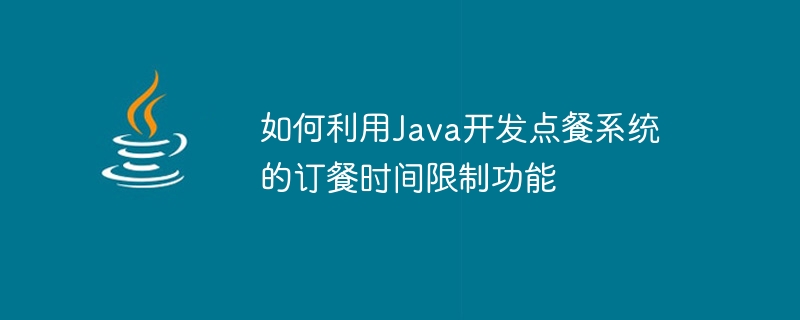Home >Java >javaTutorial >How to use Java to develop the ordering time limit function of the ordering system
How to use Java to develop the ordering time limit function of the ordering system
- WBOYWBOYWBOYWBOYWBOYWBOYWBOYWBOYWBOYWBOYWBOYWBOYWBOriginal
- 2023-11-01 15:32:02861browse

How to use Java to develop the ordering time limit function of the ordering system
With the advancement of technology and the convenience of life, more and more catering industries have begun to adopt Ordering system to provide better service. In the ordering system, a very important function is the ordering time limit. Through reasonable settings, customers' dining time can be effectively controlled and the restaurant's usage efficiency can be improved. This article will introduce how to use Java to develop the ordering time limit function of the ordering system.
1. Requirements analysis
Before starting development, we must first analyze the requirements. In the ordering system, the main requirements for ordering time limits are as follows:
- Set business hours: The restaurant needs to set the daily business start time and end time.
- Reservation time limit: Customers need to limit the optional reservation time period when ordering meals, for example, they can only reserve meal times one day in advance.
- Dining time limit: Customers need to limit the dining time period when dining, for example, the dining time for each table is 1 hour.
2. System design
Based on demand analysis, we can design the following system architecture:
- Database design: We need to create a restaurant information table and a booking record form. The restaurant information table includes information such as the restaurant's business start time and end time, and the reservation record table includes the reservation time period, customer information, etc.
- Back-end development: Use Java to develop the back-end interface, including functions such as setting restaurant business hours, querying optional reservation time periods and reservations.
- Front-end development: Use HTML, CSS and JavaScript to develop the front-end interface, including functions such as selecting a reservation time period and submitting a reservation.
3. Database design
In the database design, we create two tables: the restaurant information table and the reservation record table. The specific table structure is as follows:
-
Restaurant information table (restaurant_info):
- id: Restaurant information ID
- start_time: The restaurant starts operating Time
- end_time: Restaurant closing time
-
Booking record table (booking_record):
- id: Booking record ID
- time_slot: Booking time period
- customer_name: Customer name
- customer_phone: Customer phone number
4. Back-end development
In back-end development, we need to write some API interfaces to implement the ordering time limit function. The specific interface design is as follows:
-
Set restaurant business hours interface (setOpeningHours):
- Request URL: /restaurant/setOpeningHours
- Request Method: POST
- Request parameters: start_time, end_time
- Return result: success or failure message
This interface is used to set the restaurant's business hours.
-
Query optional reservation time period interface (getAvailableTimeSlots):
- Request URL:/restaurant/getAvailableTimeSlots
- Request method: GET
- Request parameters: None
- Return result: Optional reservation time period list
This interface is used to query the optional reservation time period, based on the restaurant's business The selectable time period is calculated from the time and reservation times already in the reservation record table.
-
Booking table interface (bookTable):
- Request URL:/restaurant/bookTable
- Request method: POST
- Request parameters: time_slot, customer_name, customer_phone
- Return result: success or failure message
This interface is used to reserve a table, and the reserved time period, customer name and Phone number and other information are saved in the booking record form.
5. Front-end development
In front-end development, we need to implement the following functions:
- Display the optional booking time period: call Query the optional booking time period interface, and display the returned optional time period list on the page for customers to choose.
- Submit reservation: Obtain the customer's selected reservation time period, name, phone number and other information through the form, and call the table reservation interface to make the reservation.
6. Summary
Through the above system design and development, we can realize the ordering time limit function. Customers can select optional reservation time periods based on the restaurant's business hours and existing reservation records, and then make reservations through the submission reservation interface. This ordering time limit function can improve the restaurant's service efficiency and also facilitate customers to dine within a suitable time period.
Developing an ordering system is a complex task, and the content described in this article alone may not be enough to meet all needs. However, through analysis of requirements and system design, it can provide a good starting point for subsequent development work. I hope this article can be helpful to readers who want to use Java to develop the ordering time limit function of the ordering system.
The above is the detailed content of How to use Java to develop the ordering time limit function of the ordering system. For more information, please follow other related articles on the PHP Chinese website!
Related articles
See more- [H5 Development Tools] Recommended 10 best HTML5 application development tools in 2017
- What is backend development? The role of back-end development and the technologies that need to be learned
- What do you need to learn about back-end development?
- What do you need to learn about Java backend development?
- How to convert list to array in java?

